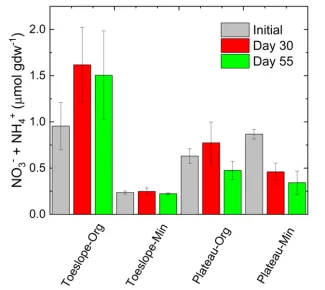Soil Geochemistry an Important Factor Influencing the rate and Magnitude of Greenhouse Gas Production in Tundra Soils
- Investigate rates and controls on CO2 and CH4 production in two contrasting water‐saturated tundra soils within a permafrost‐affected watershed near Nome, AK.
- Field observations showed that porewater geochemistry varies up- and down-slope along an elevational gradient.
- Higher pH, higher N availability for microorganisms, and higher availability of fermentable DOC, were sufficiently different along the hillslope to drive significant differences in greenhouse gas production.
- Results suggest that the weathering and leaching of ions and nutrients from tundra hillslopes can increase the rate of anaerobic organic matter decomposition and CO2 and CH4 production in downslope soils.
Philben, M, N Taş, H Chen, SD Wullschleger, A Kholodov, DE Graham, and B Gu. 2020. Influences of Hillslope Biogeochemistry on Anaerobic Soil Organic Matter Decomposition in a Tundra Watershed. JJournal of Geophysical Research: Biogeosciences, 125:e2019JG005512. https://doi.org/10.1029/2019JG005512
This research was supported by the Director, Office of Science, Office of Biological and Environmental Research of the US Department of Energy under Contract No. DE-AC02-05CH11231 as part of the Next-Generation Ecosystem Experiments (NGEE Arctic) project.
For more information, please contact:
Baohua Gu
gub1@ornl.gov

